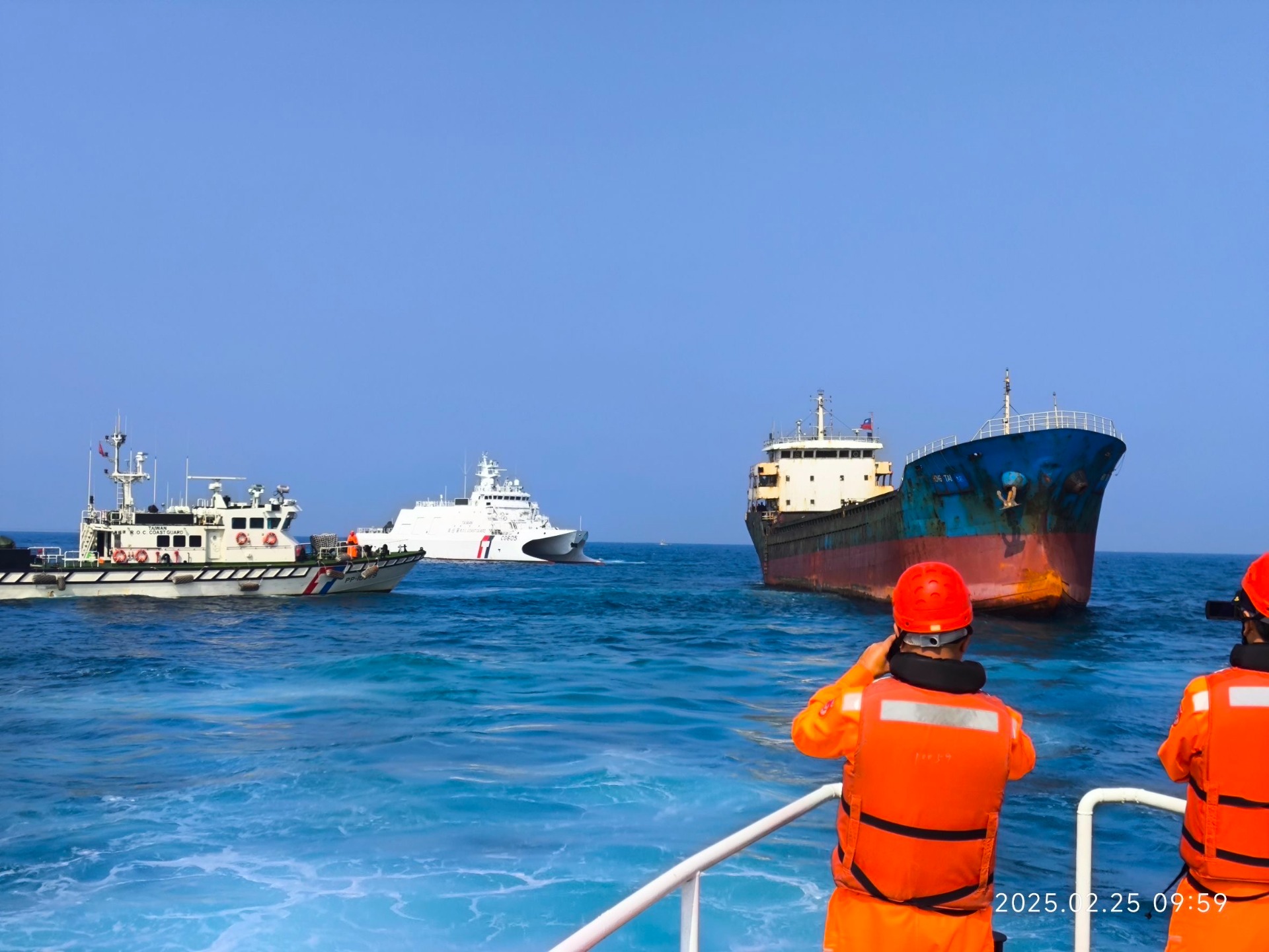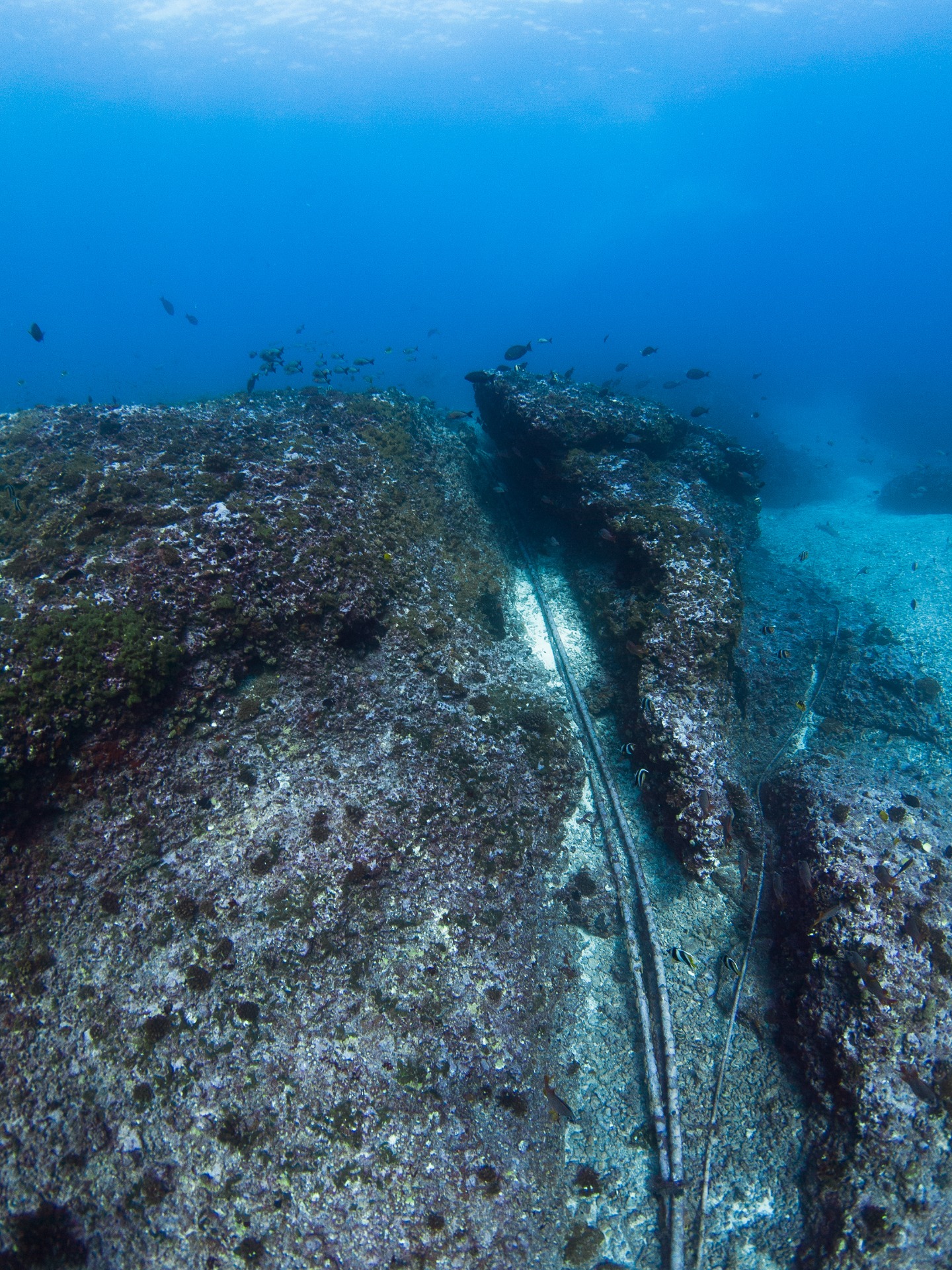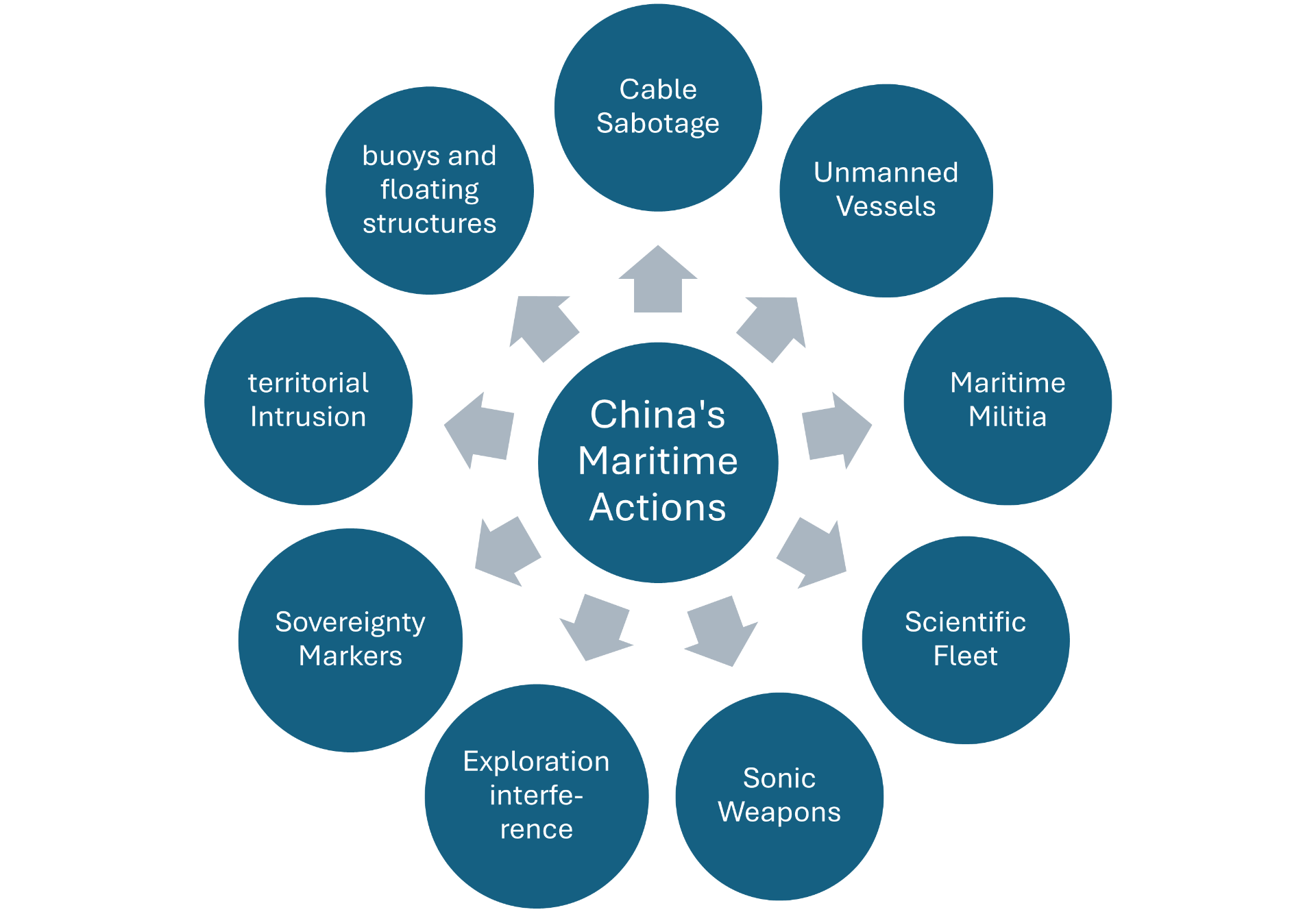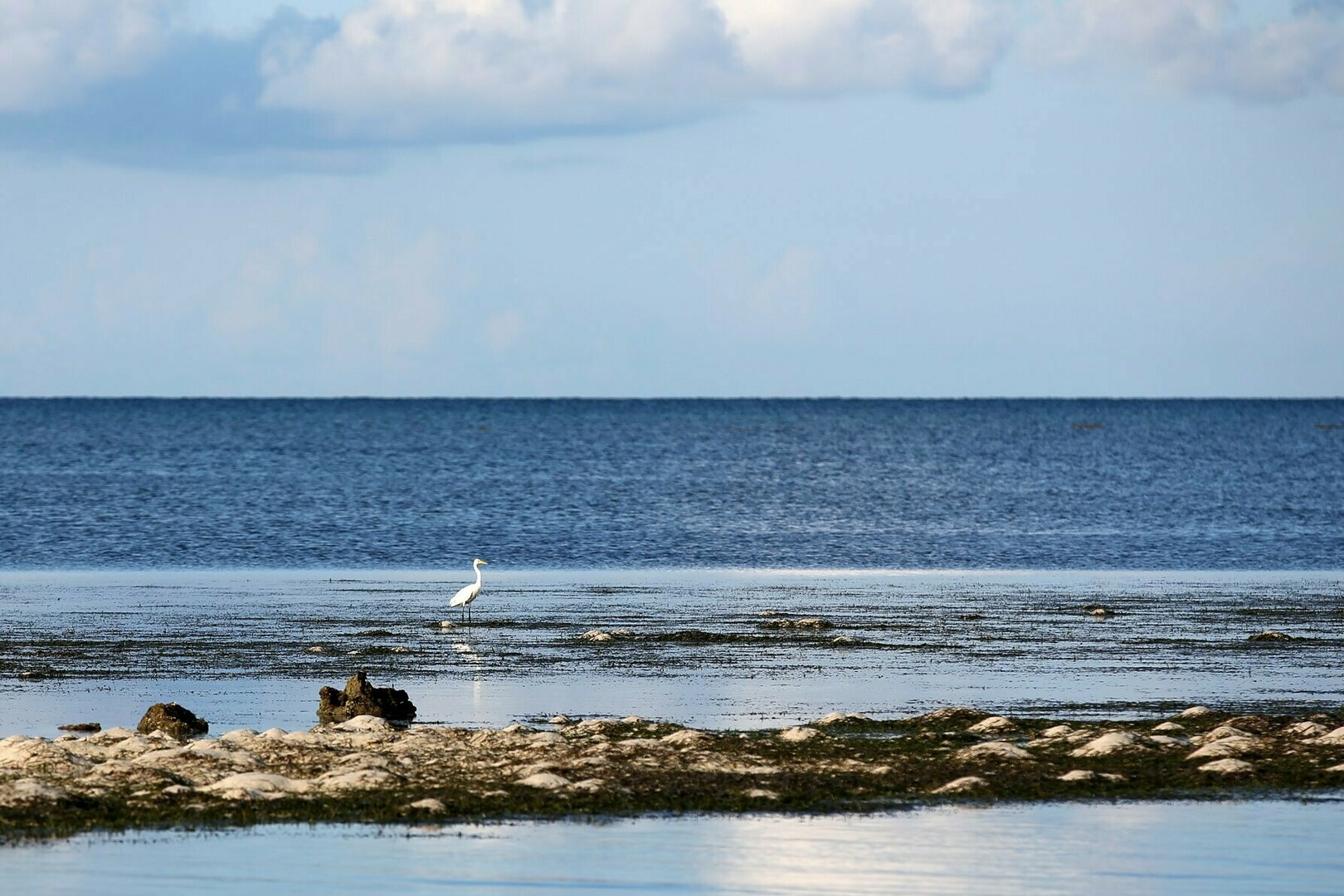Vol. 35
國際海洋資訊
International Ocean Information
From the Taiwan Strait to the Baltic:
A History of China's Maritime Actions
Benjamin Blandin
Maritime Security Expert, Non-Resident Fellow at YCAPS and KIMS
KEY WORDS | Submarine Cable Security, China's Maritime Strategy,Regional Security
China's evolving maritime strategy has manifested through a pattern of increasingly assertive actions across multiple seas, with Taiwan experiencing the most direct and substantial effects. This article examines the systematic nature of these activities and their broader regional security implications.
Over the past years, Taiwan has faced an escalating series of challenges directly or indirectly connected to China. In the maritime domain specifically, Chinese assets—including navy vessels, coast guard ships, maritime militia, and civilian vessels—have intensified their intrusions across the Median Line and into restricted waters around Taiwan's outlying islands such as Kinmen and Pratas, most notably during operations like the Joint Swords exercises.
Suspicious Frequency of Submarine Cable Disruptions
Here's a particularly concerning trend in recent months: a series of suspicious undersea cable disruptions. On February 25,2025, the Taiwan-Penghu No. 3 subsea cable was severed by a Togo-flagged cargo ship named Hong Tai 58; A month earlier on January 3,2025, another cable off Taiwan's northeastern coast was damaged by the Cameroon-flagged vessel Shunxin-39 (registered in Tanzania). These incidents share significant commonalities: both ships had Chinese crews, and Shunxin-39 was owned by a Hong Kong company with documented mainland Chinese connections.
While cable outages occasionally occur due to natural causes (earthquakes, tsunamis, landslides) or accidents (fishing activities, anchor drags during storms), the statistical frequency in Taiwan's case stands out beyond what could be there by natural chance. Taiwan has reported five undersea cable malfunctions in 2025 alone—an increase from three incidents each in 2023 and 2024. In fact, Taiwan's Chunghwa Telecom has documented 27 cable-related incidents over the past five years (2021-2025), averaging five annually—a rate far exceeding normal probability patterns.
Regional Disturbance in Vietnam, the Philippines, and the South China Sea
This phenomenon was also found beyond Taiwan's immediate waters. Both Vietnam and the Philippines have experienced similar suspicious incidents affecting critical cables traversing the South China Sea. The Asia-America Gateway (AAG) cable—a vital connection linking Southeast Asia to the United States—has suffered repeated disruptions near Vũng Tàu, south of Ho Chi Minh City. Major outages affecting up to 40% of capacity occurred in 2011, 2014, 2015, 2017, 2022, and 2023, among them several times within a single year. Similarly, the Asia-Pacific Gateway (APG), Intra-Asia (TGN-IA), and Asia-Africa-Europe-1(AAE-1) cables experienced simultaneous disruptions in 2022 and 2024, while the Thailand-Vietnam-Hong Kong (TVH) cable was vandalized in both 2007 and 2009, resulting in months-long service interruptions.
A revealing pattern emerges when analyzing these incidents: disruptions frequently occur on cable sections closest to Hong Kong, particularly connections between Hong Kong and the Philippines. Notably, China itself has remained largely unaffected by these outages, and cables with majority Chinese ownership have suspiciously avoided damage entirely.

Figure 1. The Togolese-flagged cargo ship "Hongtai 58", with Chinese capital background, allegedly severed the third Taiwan-Penghu submarine cable. The Coast Guard Administration dispatched personnel to escort it back to Anping Port in Tainan.
Photo Credit: Press Release of Coast Guard: Administrahttps://www.cga.gov.tw/GipOpen/wSite/ct?xItem=164475&ctNode=650&mp=999 tion
Global Expansion and Multi-Faceted Ocean Activities

Fig. 2 Submarine Cables Laid Among Seabed Rocks
Photo Credit: https://www.shutterstock.com/zh-Hant/image-photo/submarine-cablesbetween-rocks-rangiroa-tuamotu-2006504573
The geographic scope of these activities extends far beyond Asia. Chinese vessels and crews have been linked to three separate subsea cable sabotage incidents in the Baltic Sea—a region of growing strategic interest to China. In October 2023, two incidents occurred in rapid succession: the Hong Kong-flagged container ship NewNew Polar Bear (operated by a Chinese company) and the Chinese-flagged cargo ship Yi Xian 6, damaged the Balticconnector gas pipeline between Finland and Estonia, and telecommunication cables that connect Estonia to Sweden/Finland and Sweden to Lithuania.
In November 2024, a third incident involved the Chinese-flagged bulk carrier Yi Peng 3, which damaged two additional cables—one connecting Sweden and Lithuania, the other linking Finland and Germany. The common factor across all incidents: Chinese captains and crews, with vessel ownership or registration tied to China.
These incidents must be viewed within China's broader maritime strategy. Over the past decade, Beijing has systematically developed a comprehensive portfolio of coercive tactics at sea, almost systematically in other countries' EEZ, including:
- Sabotaging towed sonar cables of oil and gas exploration vessels
- Damaging subsea communications cables
- Deploying its "scientific fleet" for intelligence gathering under civilian cover
- Utilizing naval assets (navy, coast guard, maritime militia) in coordinated operations
- Installing buoys and floating structures in disputed waters
- Deploying sovereignty markers undrwater at James Shoal, in Malaysia's EEZ
- Conducting radio challenge to boats and planes
- Employing calculated violence against boats and planes of other nations (ramming, water cannoning, sonic and optical weapons)
- Mascerading maritime militia vessels into coast guard vessels
- Placing intelligence devices in other nations' maritime zones
- Assigning Chinese names to undersea landscapes in other nations' maritime territories to support its historical claims to those waters
- Deploying increasingly sophisticated surface and subsea drones
- Organizing "patriotic cruises" and oath swearing ceremonies into disputed waters and on/atop disputed maritime features to normalize territorial assertions
China's interference with other countries' exploration vessels is well-documented, as exemplified by the "Binh Minh 02" incidents of May 26, 2011, and November 30, 2012, where Chinese vessels deliberately severed cables of Vietnamese survey ships operating in Vietnam's claimed waters.
More recently, Chinese undersea drones have been discovered with alarming frequency throughout the region: at least one in Indonesian waters in 2024, five in Philippine waters in 2024 (with another already in 2025), and one in Vietnamese waters in 2023. These underwater surveillance platforms represent a newer dimension of China's maritime presence strategy.
Supporting these activities is China's extensive "scientific fleet"—comprising at least 64 vessels of various types and sizes provided by organizations with direct or indirect links to the PLA Navy, the Communist Party, or the Chinese government. These include oil and gas companies (China Oilfield Services Ltd and Sinopec Offshore Oilfield Services), academic institutions (Chinese Academy of Science, Sun Yat-sen University of China, Ocean University of China, Xiamen University), maritime security agencies (Maritime Safety Administration of China, Chinese Coast Guard), government ministries (China's Ministry of Natural Resources), and industry associations (China Ocean Mineral Resource Association). Security analysts have identified approximately 80% of these vessels as suspicious based on their activities, previous PLA ownership, or continued operation by security forces.
Finally, China, since the 1950s, has been developing a maritime militia that now accounts for 200 permanent vessels, equipped with reinforced hulls and specialized equipment for grey zone tactics missions, in addition to which 800 other fishing trawlers contribute on an ad hoc basis. In total, it is said by some experts, that the Chinese government could call up to 8000 boats and 15,000 crew. Recently, it has been proven that some maritime militia vessels even got their hull repainted in white with the mention "CHINA COAST GUARD", one more way to generate confusion among legal and lawful actors of the area.

▲Figure 3. Combination of Chinese Maritime Coercion Tactics
Photo Credit : The Editorial Team
The Emerging Pattern and Its Strategic Implications
While no single incident definitively proves a coordinated Chinese policy to target Taiwan's communications infrastructure, the cumulative evidence reveals a consistent pattern that aligns with broader Chinese maritime objectives. This assessment gains credibility when viewed alongside China's systematic maritime pressure against all its neighbors: Japan in the East China Sea, South Korea in the Yellow Sea's provisional measures zone, Indonesia, Malaysia, the Philippines and Vietnam in the South China Sea, and Taiwan across multiple maritime domains.
The security of subsea cables represents a critical yet often overlooked dimension of national security. For Taiwan specifically, these communication lifelines are essential for economic prosperity, digital connectivity, and national resilience. The increasing frequency and sophistication of cable disruptions pose a significant threat— one that could rapidly escalate during periods of heightened tension.
China's recent public unveiling of a specialized deep-sea cable-cutting drone, developed by the China Ship Scientific Research Centre (CSSRC) and capable of severing even the most fortified underwater communication cables at depths up to 4,000 meters, signals a disturbing new phase in this maritime strategy. This technology demonstration serves both as a capability advertisement and as a subtle form of strategic messaging to Taiwan and its partners.

▲Figure 4. Dongsha Atoll National Park
Photo Credit :Dongsha Atoll National Park : https://dongsha.marine.gov.tw/zh_tw/online/photo
Conclusion: Beyond Coincidence
The pattern of maritime incidents described in this article reflects a deliberate, multi-faceted approach to maritime dominance that extends well beyond conventional naval operations. For Taiwan and other regional states, enhanced monitoring capabilities alone are insufficient to address this vulnerability. Also required are diplomatic coordination, diversification of communication pathways, and development of rapid repair capacities.
As tensions continue to evolve in the Indo-Pacific region, policymakers must recognize these "gray zone" maritime activities as part of a larger strategic framework rather than isolated incidents. The security of critical undersea infrastructure will increasingly become a central element of regional security planning, requiring innovative defensive measures and international cooperation to ensure resilience against this emerging threat vector.
The evidence in this article suggests that we are witnessing not random accidents but rather systematic testing and deployment of a sophisticated maritime strategy— one that could have profound implications for Taiwan's security, and for regional stability in the years ahead.